Package Highlights:
- HUGE 160+HP Power Gains for Bolt-On Setups!
- Excellent “big cam” drive-ability and reliability for a trip to work, across the country, or the track
- Power band matches traditional heads/cam bottom end and mid-range with a 20% wider top end and increased operating range of 500+rpm
- Top-Performing components perfectly matched to provide “MAX Effort” performance right out of the box
- No compromises bolt-on package, no fly-cutting or machining, all components included for a complete installation
Designing the best LS3 Head and Cam Package.
We just can’t seem to leave things alone, and our MAX Package 2.0 is no exception! For several months the team has been working on improving a product that is already pretty darn good! But hey, at GPI, that’s what we do.
For those unfamiliar with the original MAX Package, we adapted an LS7 cylinder head for use on the comparatively smaller bore of the LS3. LS7 cylinder heads have an absolutely incredible port right from the factory and offer a decreased valve angle which opens up piston-to-valve clearance and allows for an increased compression ratio, and more camshaft design real estate over an LS3-style cylinder head. We paired those heads with a camshaft spec’d to take advantage of these benefits, and our original MAX Package was indeed a strong performer.
Why the Best LS3 Heads and Cam Packages uses LS7 Heads?
For our fresh take on the MAX Package, we went to work by starting with a fresh Brodix BR7 casting made here in the USA. The BR7 casting offers a thicker deck and allows us greater latitude to design the best cylinder head we can, that the OE casting could never provide. Also note, that the thicker deck surface increases the clamping force and reliability for those who might want to do a power adder. The cylinder head in our original MAX Package required offset dowels and forced us to compromise some port velocity and swirl numbers to work on the smaller 4.065 bore. This casting allowed us to engineer a no-compromise product that only our team can provide the market; A true bolt-on cylinder head that’s designed to DOMINATE!
This head is specifically designed for a medium bore engine from 4.0” to 4.085 (see chart below to view ideal applications for MAX Performance 2.0). We anticipate 90% will find their way to a 4.065 cylinder so that’s what we targeted with the chamber width.
LS Engine Bore & Stroke Chart
| Engine Size | Bore | Stroke |
|---|---|---|
4.8L (293 c.i.d.) | 3.780 in. | 3.268 in. |
5.3L (325 c.i.d.) | 3.780 in. | 3.622 in. |
5.7L (346 c.i.d.) | 3.898 in. | 3.622 in. |
6.0L (364 c.i.d.) | 4.000 in. | 3.622 in. |
6.2L (376 c.i.d.) | 4.065 in. | 3.622 in. |
7.0L (427 c.i.d.) | 4.125 in. | 4.000 in. |
With a blank canvas, we set out to design a better-suited port and valve size arrangement for the 4.065 bore size. Our original MAX Package had a port volume and valve size that was larger than ideal for the 4.065” bore we are targeting. The sweet spot for an inline, non-canted intake valve on an LS engine appears to be around 53% so we developed our port around a 2.165 valve with a 90% throat.
Here is some comparative flow data between our GPI – Ported LS3 / L92 / L99 / LSA Cylinder Heads and our new MAX Performance 2.0 Cylinder Heads.
One advantage of the LS7 cylinder head is the 12 deg valve angle. This not only makes the chamber more efficient and the valve less shrouded, but also frees up some piston to valve clearance. This is especially helpful when attempting to fit as much camshaft and compression as possible into a stock engine with no intake valve reliefs in the pistons.
We are able to maintain a .145” intake free drop at 65CC with the MAX Package 2.0. This allows the MAX Performance Camshaft to clear with a .051” head gasket which at 65CC equates to 11.3:1 static compression ratio and a 93 Octane friendly dynamic compression ratio of 8.2:1. This is truly a “have your cake and eat it” combination where we have both more dynamic compression AND more camshaft that a SBE 821/823 combo running our SS4 NFC cam. For our customers wishing to simply bolt-on power without going into the short block or flycutting the pistons, this is your ultimate solution!
The second advantage of the LS7 intake runner is that it is placed about .400″ higher on the intake flange than its LS3 counterpart. This makes for a straighter path to the valve, allowing improved airflow at a given dimension. With the LS7 intake port comes the requirement to run an LS7 intake manifold. These manifolds, designed for the larger displacement and RPM capability of the LS7, offer big plenum volumes and support larger throttle bodies, and make a great upgrade for a hot LS3 setup like the MAX Package.
As impressed as I know you must be with our math skills and fancy charts, the dyno always has a way of cutting thru the BS, so we have provided the real-world results of our testing on the same short block we have used for over 2 years for all our LS3 based cam, head, and intake testing. The results below reflect the testing of the same short block, same intake, and exhaust, in the same dyno cell with the same operator using the same “STD” Standard correction factor.
Who is the MAX Performance Package 2.0 for?
Our core audience for this package is the guy (or gal) that wants to make big power like their buddy’s high-ram setup- but without losing the stock hood and modifying the cowl.
The new MAX Performance Package works great with OEM-style manifolds and offers a true, 100% plug-and-play “install in your garage” solution while returning with big, custom NA build results.
For those of you not interested in sacrificing your hood and cowl for the Hi-Ram performance, we thought it might be helpful to test the MAX Performance 2.0 with a more conservative manifold.
Engine Dyno Tuning the MAX Performance Package 2.0
We had used the MSD Atomic intake manifold for the original MAX Package, however due to comparable performance in the target RPM range, as well as the much improved midrange torque delivered by the redesigned head, we went with the Fast LSXR. It doesn’t have the throttle body to belt tensioner interference issue on a 5th gen Camaro experienced with the MSD, it clears the taller rocker cover rails of the BR7 heads without modifications (the MSD needs to be clearanced), and it retains the LS3 fuel rail as opposed to having to buy a LS7 one. The other reason was that MSD doesn’t offer an LS3 version of their manifold so we had no comparative data.
This is a comparison of the MAX Package 2.0 vs the ported LS3 OE heads with a mid runner config of the Fast LSXR. It’s important to note that the LS7 Fast LSXR can only be equipped with a long runner, which does temper the extreme top end a bit compared to the mid-length runner in the LS3 Fast LSXR used in the comparison. This gives the MAX Performance package a bit of a midrange torque advantage while giving away some top-end compared to the ported LS3 OE heads/mid runner Fast LSXR in the higher RPM range. This provided us with the best relative comparison given the working RPM range of both tests. The longer runner manifold likely matches best with the real world use of this package, and the marginal losses out past 7,000rpm are a more than reasonable trade-off for the big, every day usable power band this configuration offers a regularly driven street and strip enthusiast.
So how much power is the MAX 2.0 Head good for?
We wanted the dyno testing to reflect the performance improvement made by the cylinder head as much as possible while providing a real-world power expectation for those considering the MAX Performance 2.0 as an option on their stock LS3 / L99 short block. The comparative data shown on the CNC ported LS3 heads with the SS4 NFC camshaft was at 10.7 to 1 compression ratio while the MAX Performance 2.0 testing was at 11.3. The MAX Performance Camshaft is 2 deg larger on both lobes but is positioned 3 degrees later so the below the curve torque is likely a break-even comparatively speaking. Based on the results of prior LS3 testing we performed, a .4 bump in compression ratio when testing chamber sizes resulted in 8 to 10 lb-ft of torque and a peak of 11 HP.
For comparison purposes, we included this chart which we reasonably estimate the SS4 NFC should have made at 11.4 compression to better reflect the MAX Performance 2.0 comparative gains as being attributable to the cylinder heads alone. The entire 53hp gains however are what should be expected for those moving from the LS3 top end (w/ ported LS3 heads and SS4NFC cam) to the MAX Performance 2.0.

The Final Testing. Chassis Dyno Results!
The ultimate and much anticipated final step in our testing was to install and chassis dyno this package in a 5th Generation LS3 Camaro to validate not only our power, but our drivability and fitment “in the real world”. Our test vehicle was a 2011 Camaro SS equipped with a manual transmission, an LS3 with our SS3 camshaft, long tube headers with cutouts, 25% underdrive pulley, ported rod-mod intake manifold, and ported 90mm throttle body. We conducted all of our baseline and final testing in speed density mode with an open throttle body to ensure induction was no factor in our results. Baseline testing revealed an already stout combination, producing just over 500 horsepower to the wheels, on 93 octane pump gas.

With the baseline numbers in hand, we pulled the Camaro into the shop and got down to the business of installing the MAX Package 2.0. Installation was straightforward and without surprises. We optioned a high-quality valvetrain, utilizing Johnson ST2116LSR short travel link bar lifters, Comp XD-A pushrods, Comp Max-Lift BSR shaft mount 1.8 rockers, and PSI 1513 ML valve springs with titanium retainers. This combination of parts gives us a very stable valve train that we can trust all the way to 8,000rpm. We took careful measurements to validate our valve-free drop, piston-to-valve clearance, and lifter preload to ensure our newly minted MAX Package 2.0 would install on the stock bottom end LS3 without modification.

Once back together, we pulled back onto the dyno to see if all these fine details would come together to produce the sort of power at the wheels we all were hoping for. The MAX Package 2.0 did not disappoint, and we cranked out 551whp, a gain of 50 horsepower at the wheels over an already very stout cammed setup. The power number itself is impressive, but even more impressive is the curve – we gave up very little down low, by 4800rpm the MAX Package 2.0 starts to separate itself from the old setup, at 6500rpm where our old combo peaked we’re still climbing, and at 7000rpm we saw our peak power, which carried out unabated as far as we were willing to spin things. Our average power gain throughout the new operating range matches closely to our peak gain of 50whp, meaning that we’re seeing the true realization of our goal, which is not just a big peak number, but a truly impressive curve that will really work on the race track.

Some of you may be thinking that surely this kind of naturally aspirated power must come with a major drivability or reliability penalty – but you would be wrong. The MAX Performance package drives every bit as well as the “stage 3” cam-only setup that was on the car when it arrived for testing. Good drivability tuning goes a long way, and when done properly this combination can truly be driven anywhere. We also validated the reliability of this package, subjecting it to a marathon 1,200-mile road trip immediately following the conclusion of our build and testing. The MAX Package 2.0 didn’t skip a beat and clicked off those 1,200 miles without issue.
In Conclusion.
As we hope you can tell, the team here at GPI has worked hard to provide you with the MAX Package 2.0. Truly represents the “ULTIMATE” bolt-on heads/cam/intake package for the 6.2L LS combination. Boasting heads/cam/Hi-ram NA power numbers with the stock hood and cowl untouched, on pump gas, is no small feat, but the MAX Package 2.0 offers just that. For the ultimate maximum effort builds adding a Hi-ram, some compression, and E85 makes 600whp on a SBE LS3 a very attainable goal with the MAX Package 2.0. Reach out to us to get started on a MAX Package 2.0 for you.
Configure a MAX Performance 2.0 Package for yourself here:
-
 GPI – MAX Performance Package 2.0 (LS3 & L99)Varies Based on Options
GPI – MAX Performance Package 2.0 (LS3 & L99)Varies Based on Options

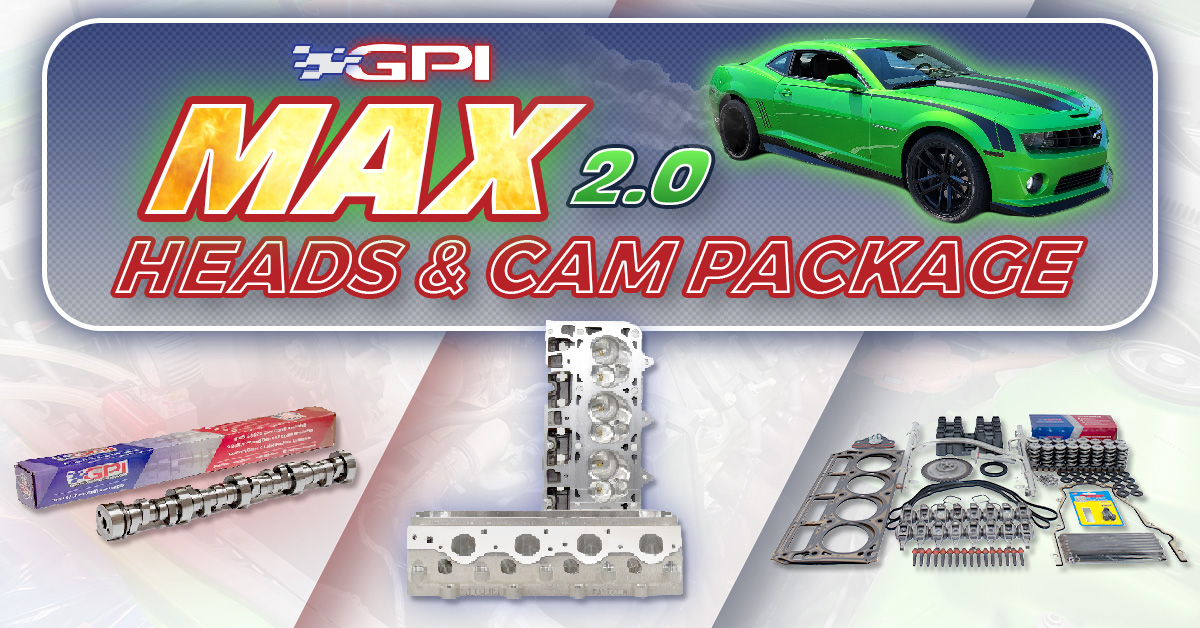


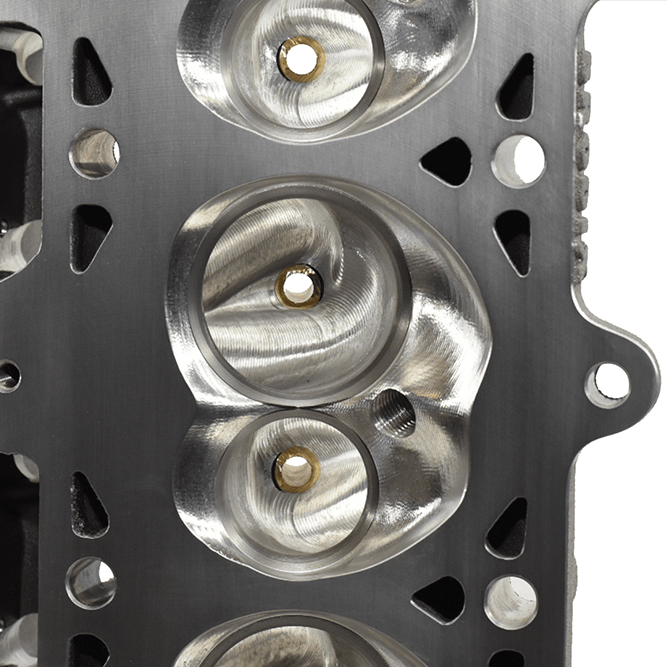
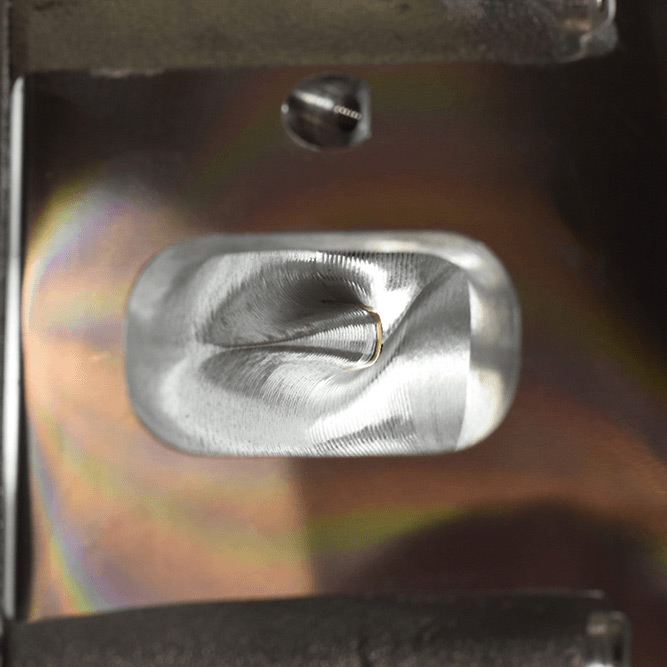


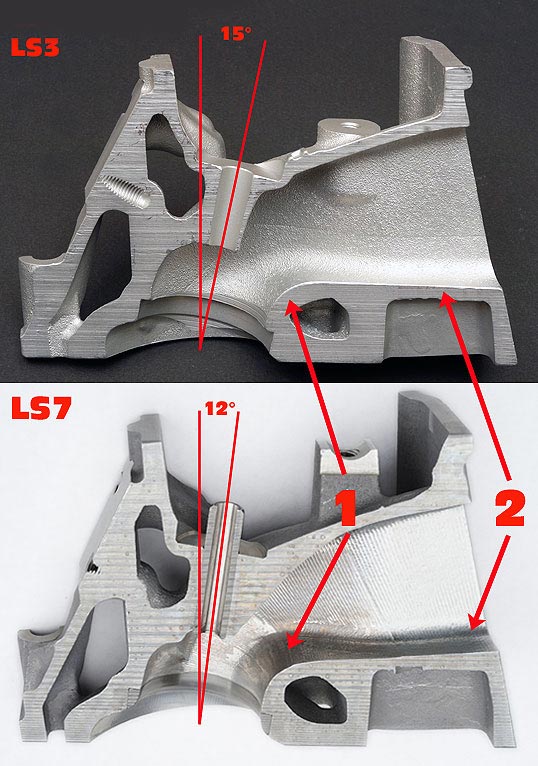



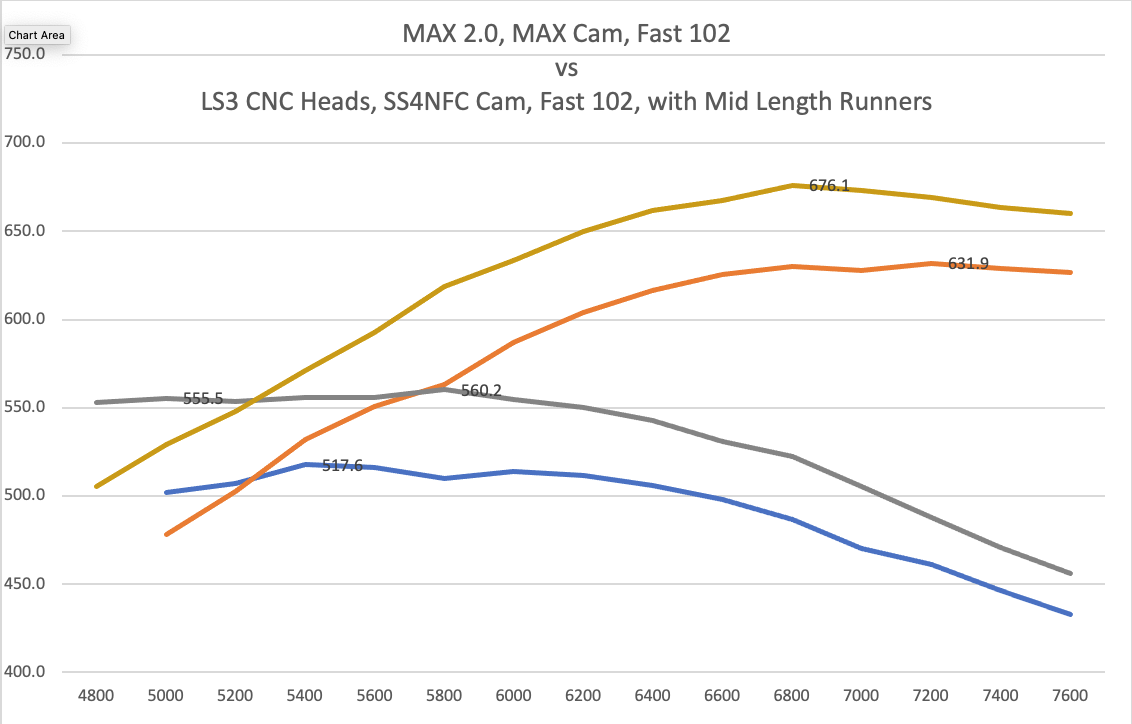
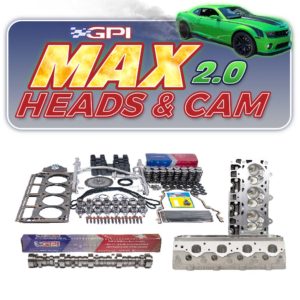
I’m installing a GPI SS4 cam on my L92. The cam is No Fly cut, non VVT, and I’ve got the cam and new valve springs installed, but I think I’m going to need different pushrods. What kind am I going to need or will the stock ones work?
I’ll be happy if you guys start doing work with the hellcat platform